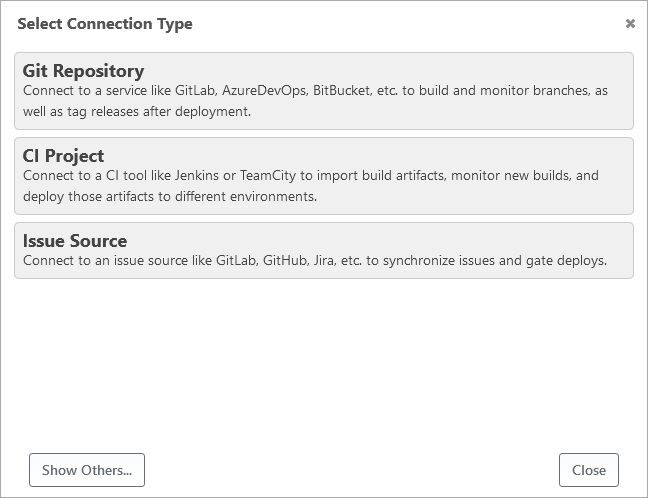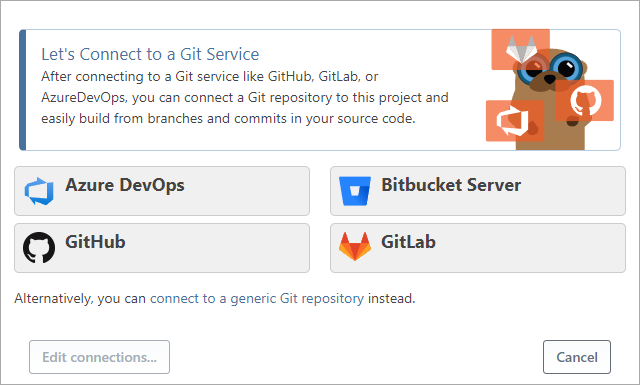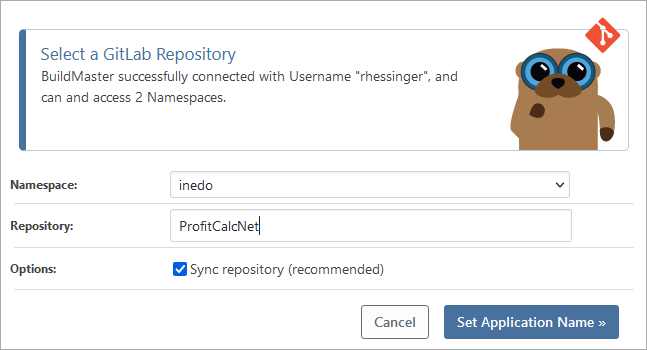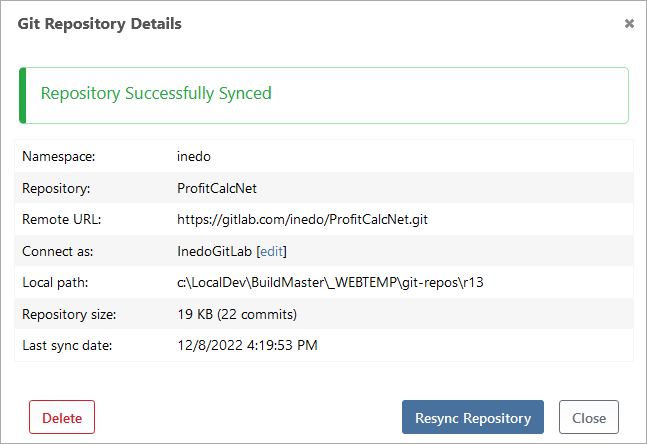Gitea
Gitea Gitea is a painless self-hosted all-in-one software development service that includes Git hosting, code review, team collaboration, package registry and CI/CD. It is similar to GitHub, Bitbucket and GitLab. While Gitea has support for its own pipelines, BuildMaster is designed to work alongside Gitea to provide a self-managed CI/CD solution using BuildMaster's Git Integration and Issue Tracking.
Connecting to Gitea
BuildMaster's Git Integration allows you to connect to Gitea at application creation or through the application's settings page. To connect BuildMaster to Gitea:
- Either create a new application or add a new connection on the application settings page, then select Git Repository

- Select the Gitea connection type

- Enter your Gitea user name and personal access token and click Select Gitea Repository

- Select your Gitea namespace and enter or select your repository and click Save Repository

The Gitea repository will then be synchronized to your server and you will see a successfully synced message.

Editing a Gitea Connection
You can edit these items directly to enable advanced scenarios (such as a shared repository) by clicking view all on the Settings page, or by going to Admin > Credentials & Resources. See Credentials & Resources to learn more.
Generating a Gitea Personal Access Token
When connecting BuildMaster to Gitea, you need to use a Gitea Access Token. To generate this token:
- Navigate to your User Profile page
- Click the Applications tab
- Enter a token name, and select the following scopes
- read_api
- write_repository
- Click Generate Token
Browsing Gitea Repositories
After adding a synchronized Gitea repository to an application, you can browse the branches, source code, and commits of that repository, as well as the changes between builds/releases, directly on the web from BuildMaster UI. See our synchronized git repositories documentation to learn more.
When viewing branch, tag, or commit details, you can also click the Browse in Gitea link to view the details directly in Gitea.
Issue Tracking
When you connect your BuildMaster application to a Gitea issue tracker, your issues are automatically synchronized with BuildMaster's issues. This allows you to browse issues, associate them with specific releases, and block releases if there are untested or unresolved issues in BuildMaster.
Gitea and Scripting
When your application uses a synchronized Gitea repository, you'll be able to create a build from any commit in the repository. When creating a build in this manner, the selected commit - along with its branch and repository - will be associated with that build and displayed throughout the UI. You can access those values in scripts with the $Commit, $Branch, and $Repository variable functions. See Git Build Scripts & Automations for more information.
Gitea Git Operations
The GitLab integration supports all the standard BuildMaster Git operations, but there are a couple things to keep in mind when using these operations.
Using Other Git Repositories
By default, Git::Checkout-Code will use your Git Connection to connect to your repository. If you would like to select a repository that is different than what your Git connection specifies; navigate to your repository in Gitea, click the "Clone" button and copy the URL under Clone with HTTPS, then set the RepositoryUrl parameter to it in the Git::Checkout-Code operation.
In cases like this, you can specify input parameters like this.
Git::Checkout-Code
(
RepositoryUrl: https://my.gitea.local/inedo/ProfitCalcNet,
BranchOrCommit: master,
To: c:\build\space\src,
CommitHash => $CommitId
);
Log-Information Checked out at $CommitId from my-repo;
Git::Set-CommitStatus Operation
Gitea allows you to set the "status" of a particular commit, as it relates to a successful build. This status is often displayed in Gitea's UI when listing commits.
To set this status in BuildMaster, you can simply call the operation with the desired status. In general, you'll want to use a try..catch statement as follows:
Git::Checkout-Code;
Git::Set-CommitStatus pending;
try
{
... perform build operations...
Git::Set-CommitStatus success;
}
catch
{
Git::Set-CommitStatus error;
throw;
}
Like the Git::Checkout-Code operation, the operation will use $Commit and $Repository if you don't specify them as parameters. The operation can also automatically determine the status, but you can override that by specifying the Status parameter:
pending- a build is about to start or is runningrunning- a build is currently runningsuccess- build completed successfullyfailed- execution didn't complete or there was an error unrelated to build compilation/testscanceled- an execution was canceled
GitCreate-PullRequest and GitMerge-PullRequest
Just like Git::Checkout-Code, the Git::Create-PullRequest operation will use your Git Repository connection to create a merge request in Gitea. Here is an example of using a repository that is different than what your Git Repository connection specifies:
Git::Create-PullRequest
(
Title: My New Thing,
Target: main,
Repository: https://my.gitea.local/inedo/ProfitCalcNet
);
This operation will also record the ID of the Pull Request on the Build, so that you can later access it with $PullRequestId.
The Feature Branch Workflow Pipeline will create a script with the Git::Create-PullRequest operation. Try it out to see this in action.
You may want to extend your Feature Branch workflow and let BuildMaster do the merging.
To complete a merge request, you can run the operation without parameters:
Git::Merge-PullRequest;
This will use the $PullRequestId if you don't specify it as a parameter.
Installing the Gitea Extension
The Gitea extension is installed by default when you install BuildMaster. You can update the extension by simply navigating to the Admin > Extensions page in your BuildMaster instance and clicking the update link to the right of the Gitea extension. Once the Gitea extension has been updated, it can be reverted back to the built-in version by navigating to Admin > Extensions > Gitea and then selecting the Change Version button in the upper right corner.
If your instance doesn't have Internet access, you can upgrade/downgrade it by manually installing the Gitea extension after downloading the Gitea Extension Package.
Built-in extensions cannot be deleted or downgraded past the included version.

